A Comparative Study of Different Milling Strategies on Productivity, Tool Wear, Surface Roughness, and Vibration
Abstract
1. Introduction
1.1. Slot Milling
1.2. Milling Strategies
1.3. Milling AA750 Aluminum Alloy
2. Materials and Methods
2.1. Materials
2.1.1. Workpiece Material
2.1.2. Milling Tools
2.2. Methods
2.2.1. Tools Preparation for PVD Deposition
2.2.2. Coatings Deposition
2.2.3. Coating Thickness and Wear Characterization
2.2.4. Machining Tests
2.2.5. Roughness Analysis of the Machined Surface
2.2.6. Tool Wear Analysis
2.2.7. Vibration Analysis
3. Results and Discussion
3.1. Coating Characterization
3.2. Machining Times
3.3. Tool Wear Analysis
3.3.1. Analysis of the Tools Used in Plunge Milling
3.3.2. Analysis of the Tools Used in Conventional Milling
3.4. Surface Roughness Analysis
3.5. Vibration Analysis
4. Conclusions
- The roughing operation carried out by plunge milling saves about 20.7% of the time needed to carry out the same work using conventional milling. Therefore, there are significant productivity gains by opting for the plunge milling strategy.
- The wear seen on tools using the plunge milling strategy is slightly lower than that seen on tools used in the conventional milling strategy.
- The tools invariably presented chipping wear and abrasive lines as the main phenomenon. This fact must be closely linked to the grade of cemented carbide used as a substrate in the tools.
- The DLCSiO500W3.5O2 coating contributed to less tool wear in the machining process as well as less adhesion of the material to be machined to the tool. This translates into a lower level of roughness, as the adhesion of the machined material to the tool normally leads to lower surface roughness.
- There is a clear relationship between the tool failure and the vibration level observed in the spindle of the CNC equipment. It was possible to correlate the tendency for a slight increase in vibration during the tests, as the wear on the tool became more severe. The chipping phenomenon was also felt, as the failure of one end of a blade was felt as a vibration peak and an increase in the overall level of vibration because of the imbalance between the different cutting edges.
- Analyzing the average RMS of the two milling processes, it can be seen that the best strategy is the conventional milling process (3.61 mm/s), which has a lower vibration level than the plunge process, preserving the useful life of the equipment long-term.
- Surface roughness is affected by the tool length and wear, being lower at the top of the slot (lower vibration of the tool) and at the beginning of the finishing process. The differences are not significant, but it seems impossible to ensure the same roughness in the hole slot surface whenever using plunge or traditional milling strategies.
Author Contributions
Funding
Data Availability Statement
Acknowledgments
Conflicts of Interest
References
- Iglesias, I.; Sanchez, A.; Silva, F.J.G. Robotic path compensation training method for optimizing face milling operations based on non-contact CMM techniques. Robot. Comput.-Integr. Manuf. 2024, 85, 102623. [Google Scholar] [CrossRef]
- Küpper, U.; Seelbach, T.; Heidemanns, L.; Prinz, S.; Herrig, T.; Bergs, T. Effects of the Manufacturing Chain on the Surface Integrity when Machining Fir Tree Slots with Alternative Manufacturing Processes. Procedia CIRP 2022, 108, 728–733. [Google Scholar] [CrossRef]
- Klocke, F.; Seimann, M.; Binder, M.; Doebbeler, B. Milling of Fir-Tree Slots in Allvac 718 plus. Procedia CIRP 2018, 77, 409–412. [Google Scholar] [CrossRef]
- Jiaa, Y.; Chia, G.; Lia, W.; Wanga, Z.; Cuia, L. Influence of Wear Pattern of Graphite Electrode on EDM Geometric Accuracy of Slot Machining. Procedia CIRP 2020, 95, 408–413. [Google Scholar] [CrossRef]
- Maradia, U.; Kliuev, M.; Baumgart, C. Efficient machining of complex-shaped seal slots for turbomachinery. CIRP Ann.—Manuf. Technol. 2018, 67, 209–212. [Google Scholar] [CrossRef]
- Li, M.; Chen, Y.; Tan, M.; Yang, X.; Xiao, Z. Surface integrity and acoustic emission characteristics during slot milling 3D carbon/carbon composites using superabrasive diamond grinding point. Diam. Relat. Mater. 2023, 137, 110166. [Google Scholar] [CrossRef]
- Silva, F.J.G.; Gouveia, R.M. Cleaner Production—Toward a Better Future; Springer: Cham, Switzerland, 2020; ISBN 978-3030231644. [Google Scholar]
- Muaz, M.; Choudhury, S.K. Experimental investigations and multi-objective optimization of MQL-assisted milling process for finishing of AISI 4340 steel. Measurement 2019, 138, 557–569. [Google Scholar] [CrossRef]
- Rodriguez-Alabanda, O.; Guerrero-Vaca, G.; Molero, E.; Romero, P.E. Experimental analysis of deep slot milling in EN AW 2024-T3 alloy by stretched trochoidal toolpath and variable helix angle tool. CIRP J. Manuf. Sci. Technol. 2021, 35, 346–360. [Google Scholar] [CrossRef]
- Li, Z.; Hu, P.; Xie, F.; Tang, K. A variable-depth multi-layer five-axis trochoidal milling method for machining deep freeform 3D slots. Robot. Comput.-Integr. Manuf. 2021, 68, 102093. [Google Scholar] [CrossRef]
- Niknam, S.A.; Songmene, V. Analysis of friction and burr formation in slot milling. Procedia CIRP 2014, 17, 755–759. [Google Scholar] [CrossRef]
- Vogtel, P.; Klocke, F.; Lung, D. High Performance Machining of Profiled Slots in Nickel-Based-Superalloys. Procedia CIRP 2014, 14, 54–59. [Google Scholar] [CrossRef]
- Jaeger, E.; Bergmann, J.A.; Wiederkehr, P. Simulation-based analysis for the machining of thin-walled, additively manufactured support structures. Procedia CIRP 2023, 118, 454–458. [Google Scholar] [CrossRef]
- Gueli, M.; Ma, J.; Cococcetta, N.; Pearl, D.; Jahan, M.P. Experimental investigation into tool wear, cutting forces, and resulting surface finish during dry and flood coolant slot milling of Inconel 718. Procedia Manuf. 2021, 53, 236–245. [Google Scholar] [CrossRef]
- Bagherzadeh, A.; Kuram, E.; Budak, E. Experimental evaluation of eco-friendly hybrid cooling methods inslot milling of titanium alloy. J. Clean. Prod. 2021, 289, 125817. [Google Scholar] [CrossRef]
- Osman, K.A.; Yılmaz, V.; Ünver, H.O.; Seker, U.; Kılıç, S.E. Slot milling of titanium alloy with hexagonal boron nitride and minimum quantity lubrication and multi-objective process optimization for energy efficiency. J. Clean. Prod. 2020, 258, 120739. [Google Scholar] [CrossRef]
- Pleta, A.; Niaki, F.A.; Mears, L. A comparative study on cutting forces coefficient identification between trochoidal and slot milling. Procedia Manuf. 2018, 26, 570–579. [Google Scholar] [CrossRef]
- Dodok, T.; Čuboňová, N.; Císara, M.; Kurica, I.; Zajačkoa, I. Utilization of strategies to generate and optimize machining sequences in CAD/CAM. Procedia Eng. 2017, 192, 113–118. [Google Scholar] [CrossRef]
- Vila, C.; Abellán-Nebota, J.V.; Siller-Carrillo, H.R. Study of different cutting strategies for sustainable machining of hardened steels. Procedia Eng. 2015, 132, 1120–1127. [Google Scholar] [CrossRef]
- Gaur, M.; Law, M. Pocket milling strategies using combined-mode and feed-direction dependent stability criteria. Procedia CIRP 2019, 82, 261–266. [Google Scholar] [CrossRef]
- Pal, P.; Tigga, A.M.; Kumar, A. A strategy for machining interacting features using spatial reasoning. Int. J. Mach. Tools Manuf. 2005, 45, 269–278. [Google Scholar] [CrossRef]
- Zhang, H.; Wang, W.; Zhang, S.; Zhang, Y.; Zhou, J.; Wang, Z.; Huang, B.; Huang, R. A novel method based on deep reinforcement learning for machining process route planning. Robot. Comput.-Integr. Manuf. 2024, 86, 102688. [Google Scholar] [CrossRef]
- Wang, Z.; Zhang, S.; Zhang, H.; Wang, W.; Zhang, Y.; Liang, J.; Huang, R.; Huang, B. Machining feature process route planning based on a graph convolutional neural network. Adv. Eng. Inform. 2024, 59, 102249. [Google Scholar] [CrossRef]
- Guo, L.; Yang, W.; Sun, J. A continuous oscillating milling strategy based on uniform wear theory for improving the service life of the ball-end cutter. Tribol. Int. 2024, 192, 109318. [Google Scholar] [CrossRef]
- Wagih, M.; Maher, I.; El-Hofy, H.; Yan, J.; Hassan, M.A. Analysis and development of elliptical tool path in trochoidal milling. CIRP J. Manuf. Sci. Technol. 2023, 47, 168–183. [Google Scholar] [CrossRef]
- Duan, Z.; Li, C.; Zhang, Y.; Dong, L.; Bai, X.; Yang, M.; Jia, D.; Li, R.; Cao, H.; Xu, X. Milling surface roughness for 7050 aluminum alloy cavity nfluenced by nozzle position of nano fluid minimum quantity lubrication. Chin. J. Aeronaut. 2021, 34, 33–53. [Google Scholar] [CrossRef]
- Bork, C.A.S.; Gonçalves, J.F.S.; Gomes, J.O.; Gheller, J. Performance of the jatropha vegetable-base soluble cutting oil as a renewable source in the aluminum alloy 7050-T7451 milling. CIRP J. Manuf. Sci. Technol. 2014, 7, 210–221. [Google Scholar] [CrossRef]
- Wang, B.; Liu, Z. Acoustic emission signal analysis during chip formation process in high-speed machining of 7050-T7451 aluminum alloy and Inconel 718 superalloy. J. Manuf. Process. 2017, 27, 114–125. [Google Scholar] [CrossRef]
- Ping, Z.; Yue, X.; Shuangfeng, H.; Ailing, S.; Baoshun, L.; Xiao, Y. Experiment and simulation on the high-speed milling mechanism of aluminum alloy 7050-T7451. Vacuum 2020, 182, 109778. [Google Scholar] [CrossRef]
- Perez, I.; Madariaga, A.; Cuesta, M.; Garay, A.; Arrazola, P.J.; Ruiz, J.J.; Rubio, F.J.; Sanchez, R. Effect of cutting speed on the surface integrity of face milled 7050-T7451 aluminium workpieces. Procedia CIRP 2018, 71, 460–465. [Google Scholar] [CrossRef]
- Chang, H.; Li, L.; Shi, R. Design and manufacturing technology of high-speed milling cutter for aluminum alloy. Procedia Eng. 2017, 174, 630–637. [Google Scholar] [CrossRef]
- Berry, L.; Wheatley, G.; Ma, W.; Nejad, R.M.; Berto, F. The influence of milling induced residual stress on fatigue life of aluminum alloys. Forces Mech. 2022, 7, 100096. [Google Scholar] [CrossRef]
- Kechagias, J. Multiparameter signal-to-noise ratio optimization for end milling cutting conditions of aluminium alloy 5083. Int. J. Adv. Manuf. Technol. 2024, 132, 4979–4988. [Google Scholar] [CrossRef]
- Fountas, N.A.; Stergiou, C.I.; Vaxevanidis, N.M. Programmable Support Functions to Assist Process Planning for Aeronautical Parts Manufacturing. In Proceedings of the ASME 2014 12th Biennial Conference on Engineering Systems Design and Analysis, Copenhagen, Denmark, 25–27 June 2014; Volume 1. Applied Mechanics; Automotive Systems; Biomedical Biotechnology Engineering; Computational Mechanics; Design; Digital Manufacturing; Education; Marine and Aerospace Applications. [Google Scholar] [CrossRef]
- Fan, W.; Zheng, L.; Ji, W.; Xu, X.; Wang, L.; Lu, Y.; Zhao, X. Function block-based closed-loop adaptive machining for assembly interfaces of large-scale aircraft components. Robot. Comput.-Integr. Manuf. 2020, 66, 101994. [Google Scholar] [CrossRef]
- Scott, C.T.; Daily, M. The development of a microcomputer CAD/CAM and decision support system for the manufacturing of aerospace vehicles. Comput. Ind. Eng. 1988, 15, 14–23. [Google Scholar] [CrossRef]
- Zhang, P.; Zhang, S.; Zhang, J.; Sun, Y.; Zhou, H.; Yue, X. Influence of milling parameters on the microstructural evolution mechanism of 7075-T6 aluminum alloy. Vacuum 2024, 222, 113100. [Google Scholar] [CrossRef]
- Ping, Z.; Xiujie, Y.; Penghao, W.; Xiao, Y. Surface integrity and tool wear mechanism of 7050-T7451 aluminum alloy under dry cutting. Vacuum 2021, 184, 109886. [Google Scholar] [CrossRef]
- ISO 4288:1996; Geometrical Product Specifications (GPS)—Surface Texture: Profile Method—Rules and Procedures for the Assessment of Surface Texture. International Organization for Standardization: Geneva, Switzerland, 1996.
- ISO 8688-2; Tool life testing in milling—Part 2: End milling. International Organization for Standardization: Geneva, Switzerland, 1989.
- Martinho, R.P.; Silva, F.J.G.; Baptista, A.P.M. Cutting forces and wear analysis of Si3N4 diamond coated tools in high speed machining. Vacuum 2008, 82, 1415–1420. [Google Scholar] [CrossRef]
- Daniyan, I.A.; Tlhabadira, I.; Daramola, O.O.; Mpofu, K. Design and Optimization of Machining Parameters for Effective AISI P20 Removal Rate during Milling Operation. Procedia CIRP 2019, 84, 861–867. [Google Scholar] [CrossRef]
- Martinho, R.P.; Silva, F.J.G.; Martins, C.; Lopes, H. Comparative study of PVD and CVD cutting tools performance in milling of duplex stainless steel. Int. J. Adv. Manuf. Technol. 2019, 102, 2423–2439. [Google Scholar] [CrossRef]
- Silva, F.J.G.; Sebbe, N.P.V.; Costa, R.D.F.S.; Pedroso, A.F.V.; Sales-Contini, R.C.N.; Barbosa, M.L.S.; Martinho, R.P.M. Investigations on the Surface Integrity and Wear Mechanisms of TiAlYN-Coated Tools in Inconel 718 Milling Operations. Materials 2024, 17, 443. [Google Scholar] [CrossRef]
- Nogueira, F.R.; Pedroso, A.F.V.; Silva, F.J.G.; Campilho, R.D.S.G.; Sales-Contini, R.C.M.; Sebbe, N.P.V.; Casais, R.C.B. A Comparative Study on the Wear Mechanisms of Uncoated and TiAlTaN-Coated Tools Used in Machining AMPCO® Alloy. Coatings 2024, 14, 4. [Google Scholar] [CrossRef]
- Sebbe, N.P.V.; Fernandes, F.; Silva, F.J.G.; Pedroso, A.F.V.; Sales-Contini, R.C.S.; Barbosa, M.L.S.; Durão, L.M.; Magalhães, L.L. Wear behavior of TiAlVN coated tools in milling operations of INCONEL 718. Coatings 2024, 14, 311. [Google Scholar] [CrossRef]
- Sousa, V.F.C.; Silva, F.J.G.; Alexandre, R.; Pinto, G.; Baptista, A.; Fecheira, J.S. Investigations on the Wear Performance of Coated Tools in Machining UNS S32101 Duplex Stainless Steel. Metals 2022, 12, 896. [Google Scholar] [CrossRef]
- Silva, F.J.G.; Martinho, R.P.; Baptista, A.P.M. Characterization of laboratory and industrial CrN/CrCN/diamond-like carbon coatings. Thin Solid Film. 2014, 550, 278–284. [Google Scholar] [CrossRef]
- Aramesh, M.; Montazeri, S.; Veldhuis, S.C. A novel treatment for cutting tools for reducing the chipping and improving tool life during machining of Inconel 718. Wear 2018, 414–415, 79–88. [Google Scholar] [CrossRef]
- Bleicher, F.; Ramsauer, C.M.; Oswald, R.; Leder, N.; Schoerghofer, P. Method for determining edge chipping in milling based on tool holder vibration measurements. CIRP Ann. 2020, 69, 101–104. [Google Scholar] [CrossRef]
- Gao, S.; Zheng, M.; Zhu, J.; Chen, J. Mechanism of adhesion failure during interrupted cutting with cemented carbide tools: Experimental and ab-initio perspective. Int. J. Refract. Met. Hard Mater. 2021, 98, 105549. [Google Scholar] [CrossRef]
- Fernandes, G.H.N.; Lopes, G.H.F.; Barbosa, L.M.Q.; Martins, P.S.; Machado, Á.R. Wear mechanisms of diamond-like carbon coated tools in tapping of AA6351 T6 aluminium alloy. Procedia Manuf. 2021, 53, 293–298. [Google Scholar] [CrossRef]
- Hovsepian, P.E.; Luo, Q.; Robinson, G.; Pittman, M.; Howarth, M.; Doerwald, D.; Tietema, R.; Sim, W.M.; Deeming, A.; Zeus, T. Surface and Coatings Technology TiAlN/VN superlattice structured PVD coatings: A new alternative in machining of aluminium alloys for aerospace and automotive components. Surf. Coat. Technol. 2016, 201, 265–272. [Google Scholar] [CrossRef]
- Abebe, R.; Gopal, M. Exploring the effects of vibration on surface roughness during CNC face milling on aluminum 6061-T6 using sound chatter. Mater. Proc. 2023, 90, 43–49. [Google Scholar] [CrossRef]
- Swan, R.; Penney, J.; Corson, G.; Nazario, J.; Schmitz, T. Surface location error in robotic milling: Effect of combined low frequency and high frequency vibration modes. CIRP J. Manuf. Sci. Technol. 2024, 49, 203–215. [Google Scholar] [CrossRef]
- Toh, C.K. Vibration analysis in high speed rough and finish milling hardened steel. J. Sound Vib. 2004, 278, 101–115. [Google Scholar] [CrossRef]
- Montassar, F.; Frédéric, M.; Johanna, S.; Walter, R. Cutting parameters and tool geometry selection for plunge milling—Analysis of cutting forces at the bottom of deep titanium workpieces. J. Manuf. Process. 2021, 62, 491–500. [Google Scholar] [CrossRef]
- Geng, D.; Sun, Z.; Liu, Y.; Liu, L.; Ying, E.; Cai, J.; Jiang, X.; Zhang, D. Unravelling the influence of vibration on material removal and microstructure evolution in ultrasonic transversal vibration-assisted helical milling of Ti-6Al-4V holes. J. Mater. Process. Technol. 2024, 326, 118320. [Google Scholar] [CrossRef]
- Chibane, H.; Morandeau, A.; Serra, R.; Bouchou, A.; Leroy, R. Optimal milling conditions for carbon/epoxy composite material using damage and vibration analysis. Int. J. Adv. Manuf. Technol. 2013, 68, 1111–1121. [Google Scholar] [CrossRef]
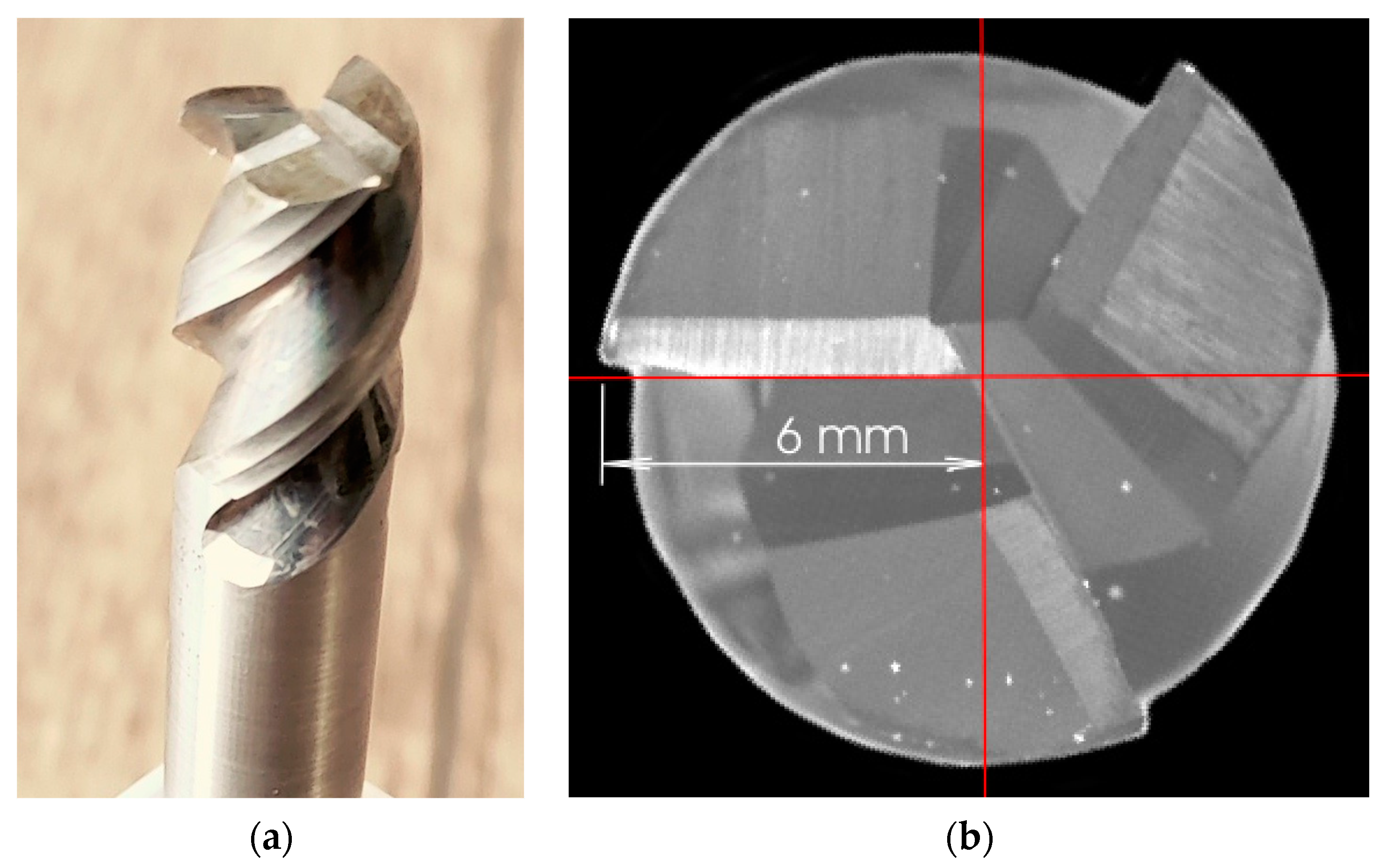
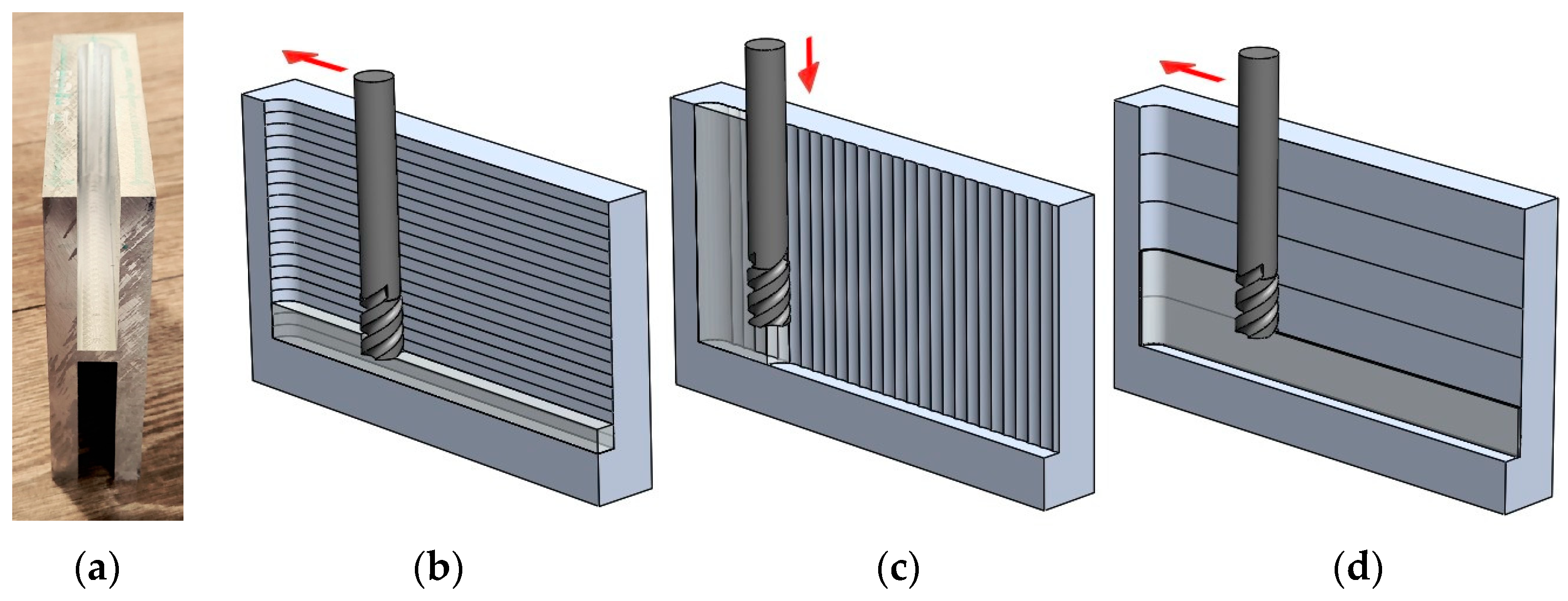


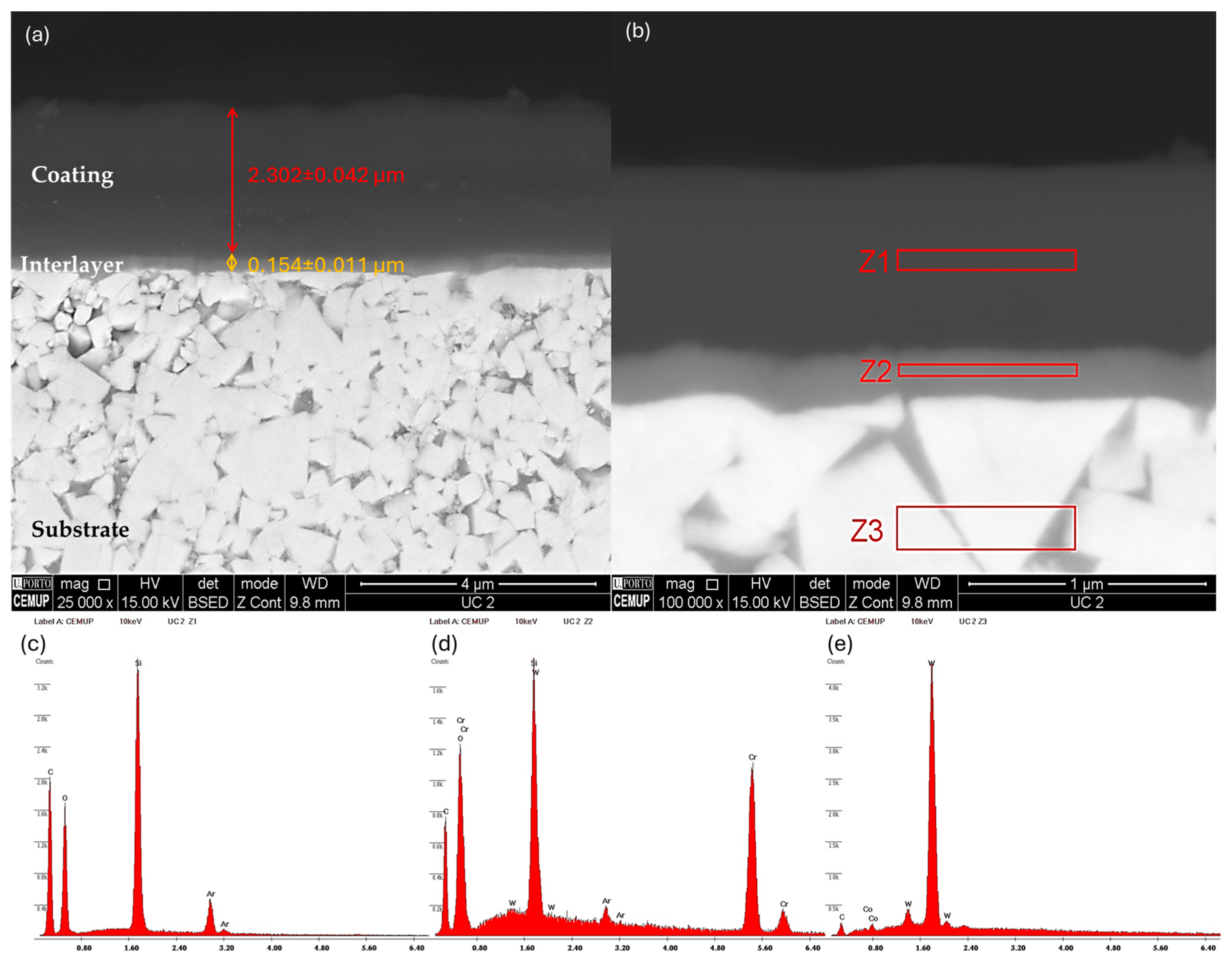

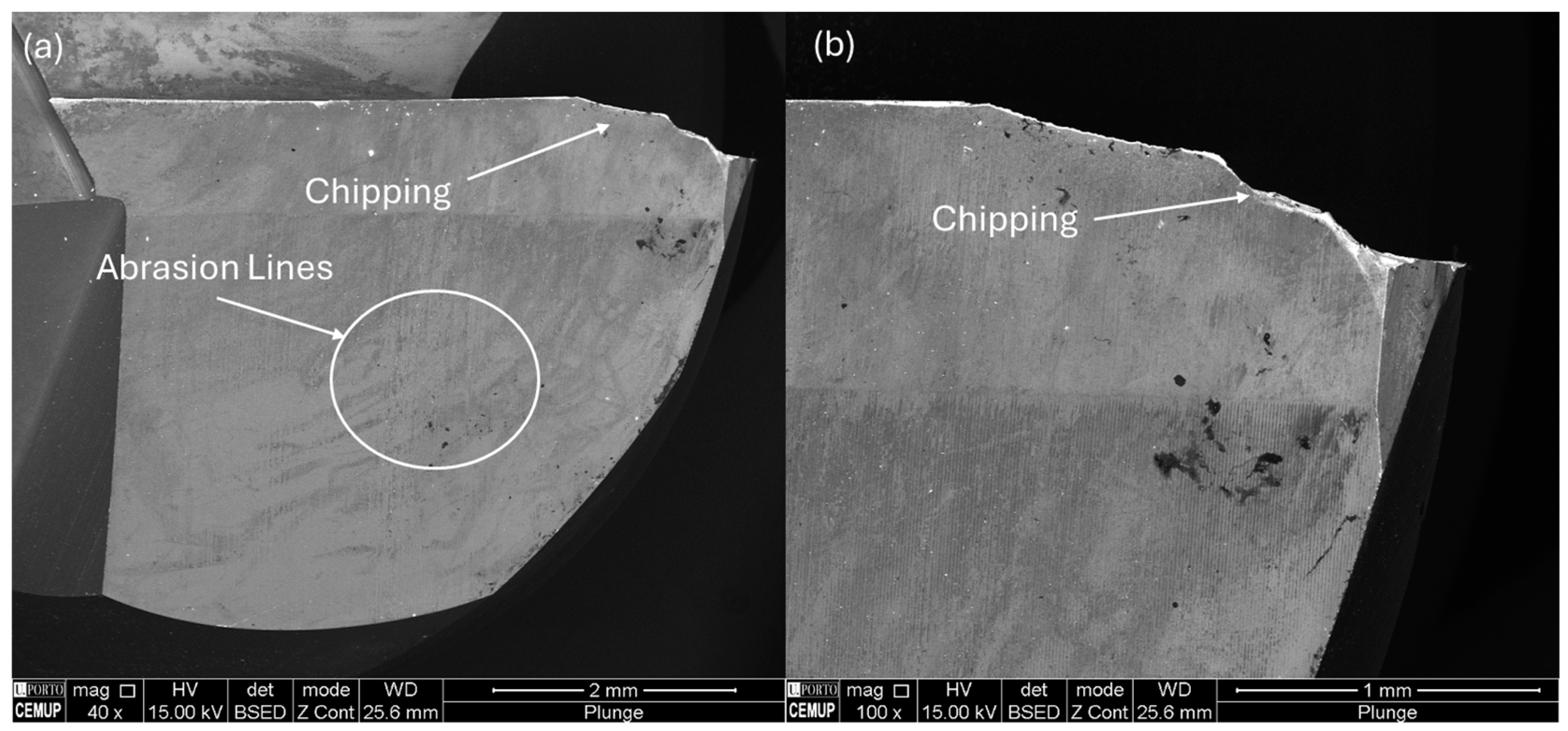
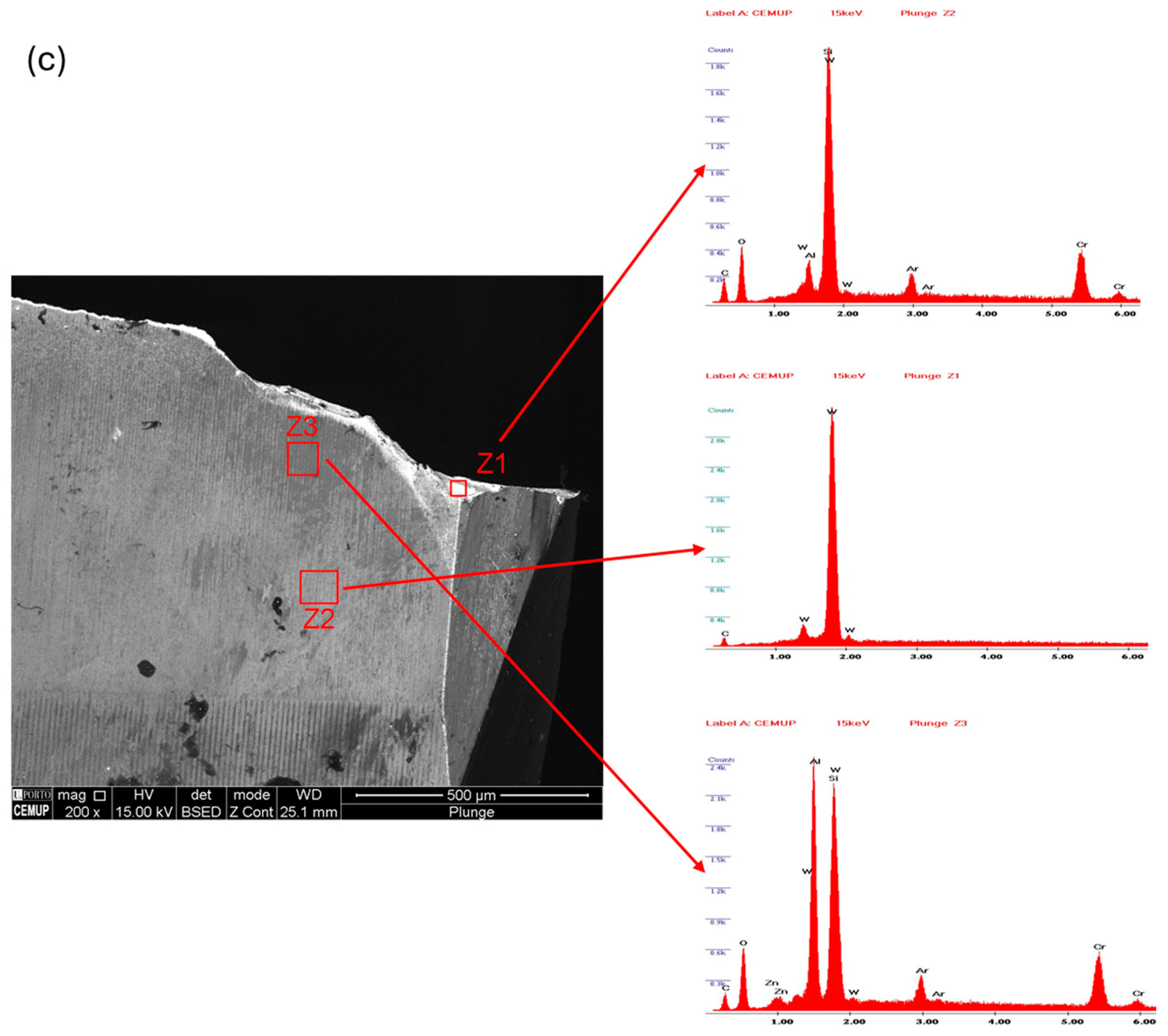

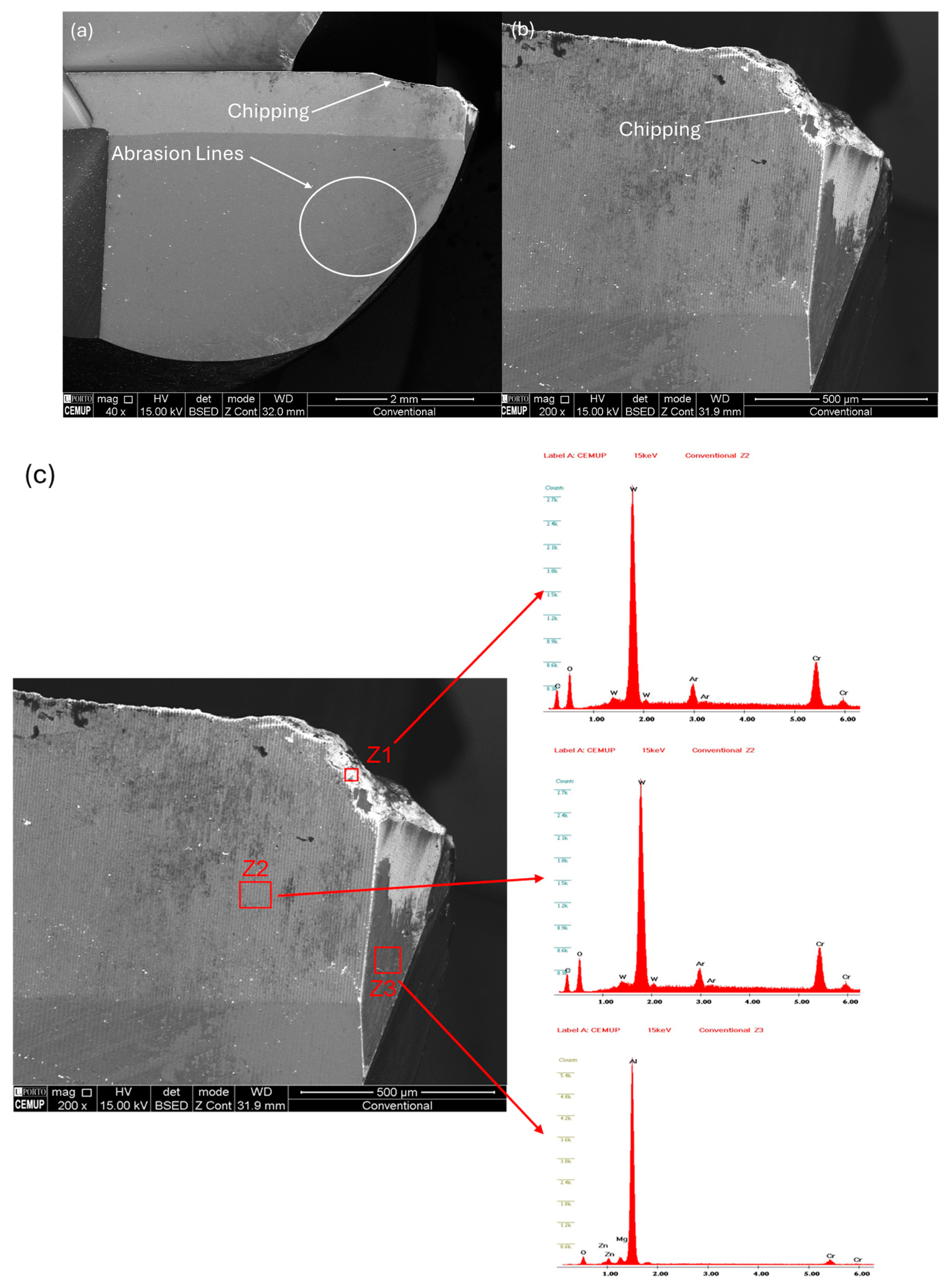
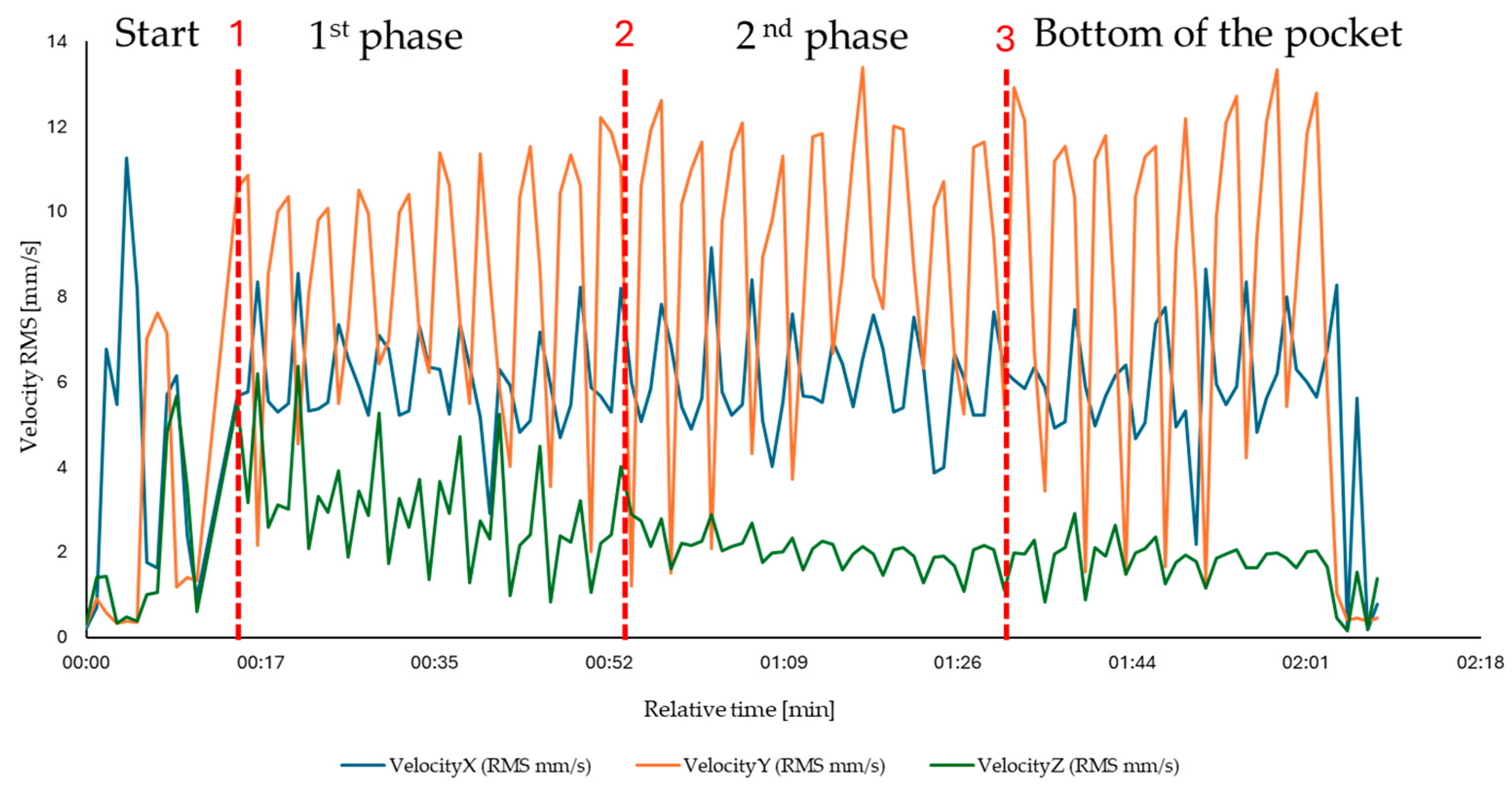

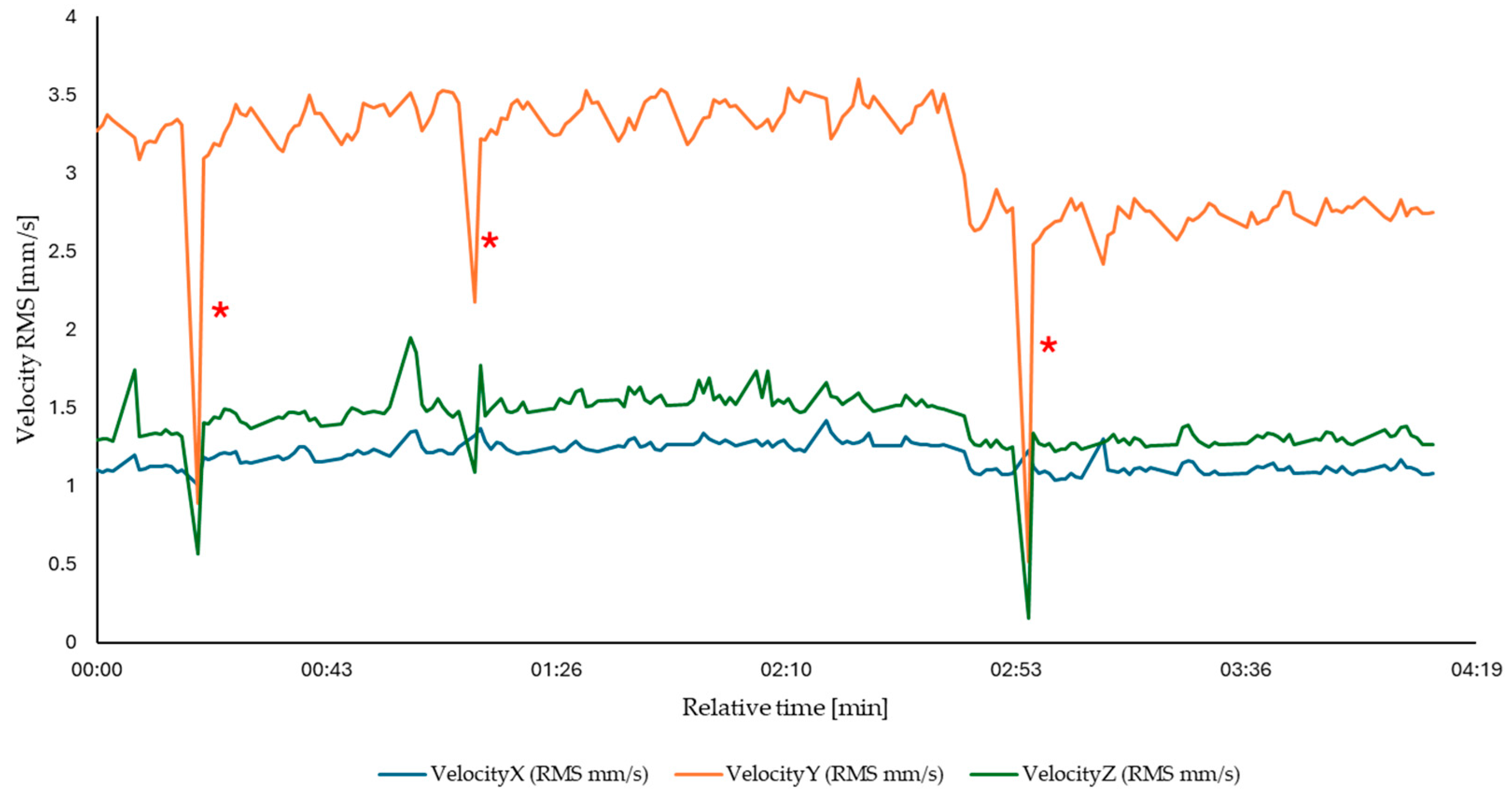
| Al | 87.3–90.3 | Mn | ≤0.1 |
| Zn | 5.7–6.7 | Cr | ≤0.04 |
| Cu | 2.0–2.6 | Ti | ≤0.06 |
| Mg | 1.9–2.6 | Fe | ≤0.15 |
| Zr | 0.08–0.15 | Others | 0.05–0.15 |
| Si | ≤0.12 |
| Mechanical Properties | Physical Properties | ||||
|---|---|---|---|---|---|
| Tensile Strength | 515 | MPa | Density | 2.70 | g/cm3 |
| Yield Strength | 455 | MPa | Melting Point | 494 | °C |
| Fatigue Strength | 240 | MPa | Modulus of Elasticity | 70–80 | GPa |
| Elongation | 11 | % | |||
| Diameter | 12 | mm |
| Shaft diameter | 11.2 | mm |
| Overall length | 100 | mm |
| Length below holder | 85 | mm |
| Shoulder length | 20 | mm |
| Flute length | 18 | mm |
| Chamfer | 0.20 × 45° | mm |
| Helix angle | 35° | |
| Cutting-edge radius | 0.21 ± 0.016 | mm |
| Cutting-edge angle | 73.8 | ° |
| Total Deposition Time | 167 | min |
| Targets | C | 2 (Positions 2 and 4) |
| Targets | Si | 1 (Position 1) |
| Power on C targets (2) | 1750 (×2) | W |
| Power on Si target | 500 | W |
| Pressure | 580 | mPa |
| Bias | −50 | V |
| Temperature | 450 | °C |
| Reactor gas 1 | Ar+ | 35 sccm * |
| Reactor gas 2 | O2 | 3.5 sccm * |
| Holder rotation speed | 1 | rpm |
| Sampling Area | Element | Wt (%) |
|---|---|---|
| Z1 | ||
| C | 43.35 | |
| O | 23.47 | |
| Si | 25.53 | |
| Ar | 7.64 | |
| Z2 | ||
| C | 8.07 | |
| O | 5.09 | |
| Si | 6.71 | |
| W | 12.68 | |
| Ar | 1.25 | |
| Cr | 66.20 | |
| Z3 | ||
| C | 2.39 | |
| Co | 2.39 | |
| W | 95.22 |
| Parameters | Plunging | Conventional | Plunging | Conventional | |
|---|---|---|---|---|---|
| Theoretical Calculations | CAD/CAM Results | ||||
| Vc | [m/min] | 160 | 160 | 160 | 160 |
| n | [rev/min] | 4244 | 4244 | 4244 | 4244 |
| fn | [mm/rev] | 0.14 | 0.14 | 0.14 | 0.14 |
| H/L | [mm] | 74 | 140 | 74 | 140 |
| ae/ap | [mm] | 4.8 | 3.7 | 4.8 | 3.7 |
| Np/Nc | - | 30 | 20 | 30 | 20 |
| tp/tc | [s] | 224.18 | 282.74 | 248.00 | 314.00 |
| Slot Upper Position | Slot Lower Position | Start of the Finishing | End of the Finishing | |
|---|---|---|---|---|
| Plunge Milling | 0.281 ± 0.018 μm | 0.438 ± 0.022 μm | 0.422 ± 0.024 μm | 0.312 ± 0.019 μm |
| Conv. Milling | 0.276 ± 0.011 μm | 0.427 ± 0.023 μm | 0.274 ± 0.013 μm | 0.283 ± 0.021 μm |
| Figure 3 | Position 5 | Position 2 | Position 1 | Position 6 |
| Slot Upper Position | Slot Lower Position | Start of the Finishing | End of the Finishing | |
|---|---|---|---|---|
| Plunge Milling | 2.224 ± 0.421 μm | 2.997 ± 0.377 μm | 3.385 ± 0.314 μm | 2.678 ± 0.296 μm |
| Conv. Milling | 2.141 ± 0.318 μm | 2.953 ± 0.329 μm | 2.132 ± 0.295 μm | 2.814 ± 0.279 μm |
| Figure 3 | Position 5 | Position 2 | Position 1 | Position 6 |
Disclaimer/Publisher’s Note: The statements, opinions and data contained in all publications are solely those of the individual author(s) and contributor(s) and not of MDPI and/or the editor(s). MDPI and/or the editor(s) disclaim responsibility for any injury to people or property resulting from any ideas, methods, instructions or products referred to in the content. |
© 2024 by the authors. Licensee MDPI, Basel, Switzerland. This article is an open access article distributed under the terms and conditions of the Creative Commons Attribution (CC BY) license (https://creativecommons.org/licenses/by/4.0/).
Share and Cite
Silva, F.J.G.; Martinho, R.P.; Magalhães, L.L.; Fernandes, F.; Sales-Contini, R.C.M.; Durão, L.M.; Casais, R.C.B.; Sousa, V.F.C. A Comparative Study of Different Milling Strategies on Productivity, Tool Wear, Surface Roughness, and Vibration. J. Manuf. Mater. Process. 2024, 8, 115. https://doi.org/10.3390/jmmp8030115
Silva FJG, Martinho RP, Magalhães LL, Fernandes F, Sales-Contini RCM, Durão LM, Casais RCB, Sousa VFC. A Comparative Study of Different Milling Strategies on Productivity, Tool Wear, Surface Roughness, and Vibration. Journal of Manufacturing and Materials Processing. 2024; 8(3):115. https://doi.org/10.3390/jmmp8030115
Chicago/Turabian StyleSilva, Francisco J. G., Rui P. Martinho, Luís L. Magalhães, Filipe Fernandes, Rita C. M. Sales-Contini, Luís M. Durão, Rafaela C. B. Casais, and Vitor F. C. Sousa. 2024. "A Comparative Study of Different Milling Strategies on Productivity, Tool Wear, Surface Roughness, and Vibration" Journal of Manufacturing and Materials Processing 8, no. 3: 115. https://doi.org/10.3390/jmmp8030115
APA StyleSilva, F. J. G., Martinho, R. P., Magalhães, L. L., Fernandes, F., Sales-Contini, R. C. M., Durão, L. M., Casais, R. C. B., & Sousa, V. F. C. (2024). A Comparative Study of Different Milling Strategies on Productivity, Tool Wear, Surface Roughness, and Vibration. Journal of Manufacturing and Materials Processing, 8(3), 115. https://doi.org/10.3390/jmmp8030115











